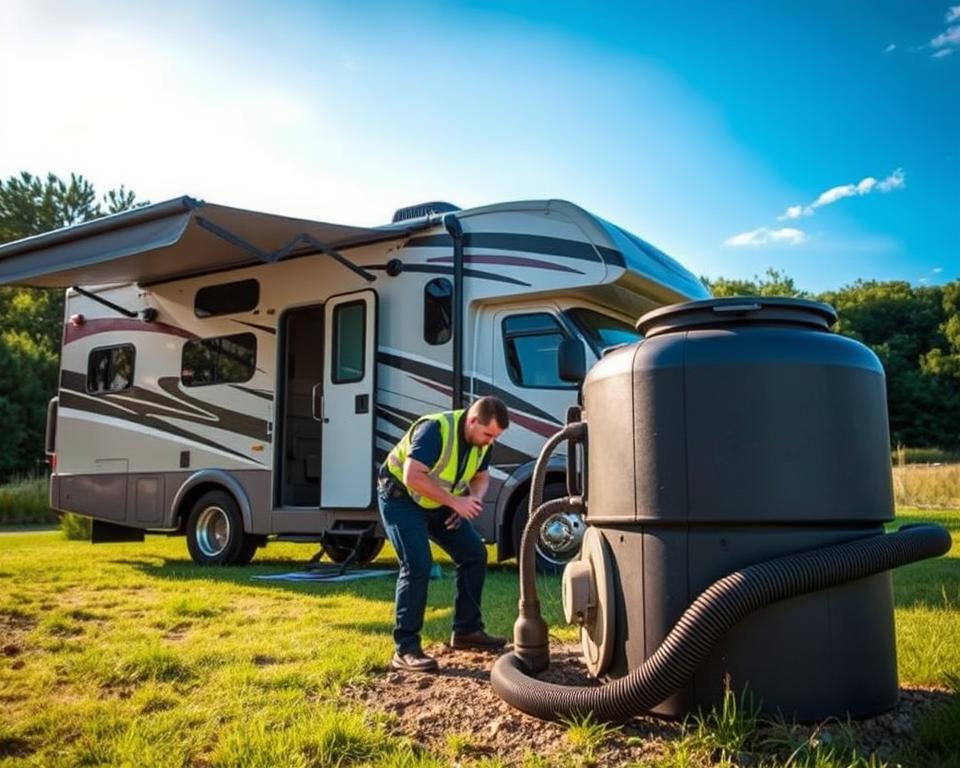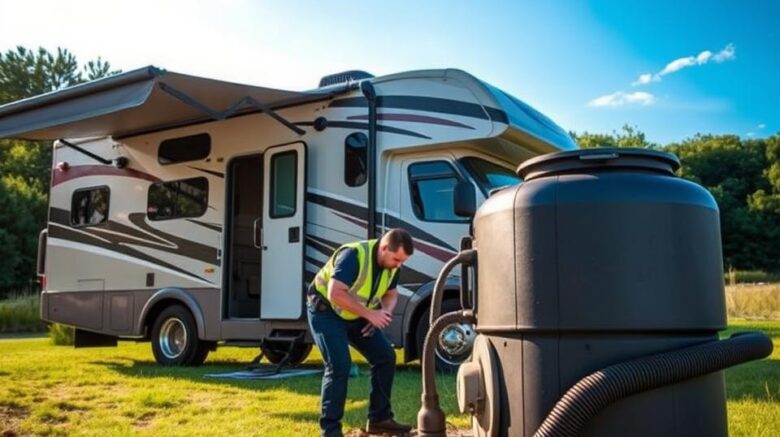RV Black Water Pump: Vital Maintenance Tips
Is your RV’s black water pump really road-ready, or might it bring about camping woes? Caring for your motorhome’s waste system in prime condition is vital. It helps sidestep unpleasant aromas, obstructions, and costly repairs. We’ll share important advice to guarantee your sewage pump operates flawlessly, keeping your travels trouble-free.
Understanding Your RV’s Plumbing System
The RV plumbing system is integral for any hassle-free adventure. It breaks down into two main parts: the black water system and the gray water system – RV water tank and pump. The black water system holds waste from the toilet, and the gray water system deals with wastewater from sinks and showers.
The systems use drain lines that lead to different tanks, designed for effective waste management. Each tank has a vent to block gas from building up, guaranteeing the operation is safe and smells fresh. Proper waste management in an RV is critical to sidestep leaks or bad odors. By learning about both black and gray water tanks, RV owners can upkeep and manage waste better.
Grasping how your RV’s plumbing works helps spot issues promptly. Routine maintenance creates carefree adventures for everyone. Staying ahead with your RV’s plumbing system delivers reliability during your travels.
RV Tank Categories
Exploring RVs involves understanding the different tanks. Each one is essential to your RV’s operation, requiring regular upkeep.
The fresh water tank stores consumption water. It’s indispensable for a pleasant RV experience.
The gray water tank gathers sink, shower, and other non-Septic wastewater. Overseeing this tank keeps your RV sanitary while traveling. The black water tank, on the other hand, contains toilet waste. It needs consistent emptying and meticulous maintenance to avoid issues.
By being familiar with the fresh, gray, and black water tanks, RV owners can smoothly run their systems. This preparedness and regular maintenance guarantee smooth functionality of the waste management system.
How RV Black Water Tanks Work
The operation of the black water tank is key in RV waste management. It stores waste from the toilet via a gravity-fed system. Upon flushing, waste and water are channeled to the tank, to be stored until removal is necessary. It’s important to keep water levels optimized in the toilet to prevent solid waste buildup.
Understanding how RV waste tanks function can circumvent clogs and odors. Without proper care, solid waste hardens, leading to blockages and emptying difficulties. Effective tank flushing techniques are critical to preventing these issues, guaranteeing smooth functionality.
Regular inspection of tank mechanics is advised for RV owners. This includes observing flushing methods and sustaining adequate water flow. Mastering these essentials helps with efficient tank maintenance, dodging expensive fixes later.

Essential Maintenance Tips for Your RV Black Water Pump
Carrying out regular maintenance on your RV’s black water pump is imperative. Start by selecting RV-safe toilet paper to lessen clogs and boost flow. A comprehensive flush can clear waste and cut bad smells. Consistently cleaning the tank helps stop residue buildup, ensuring your RV hygienic and comfortable.
Carry out periodic inspections to check your pump’s condition. Look for any signs of wear or damage that could reduce its function. Using specialized tank treatments, like those from All in Sanitation, can considerably enhance both performance and cleanliness. Adhering to these tips can prolong your pump’s life and better your RV’s living conditions.
Opt for RV-Specific Tissue
Maintaining your RV’s black water system includes vital steps. One essential tip is using RV-safe toilet paper for clog prevention. This purpose-made product softens quickly in water, tailored for RV sanitation systems.
RV-safe toilet paper is essential for tank maintenance. It dissolves fast, minimizing blockages from slow-decomposing materials. This enhances waste disposal efficiency and keeps the plumbing smooth.
Choose brands labeled as RV-safe when buying toilet paper. These products lessen clog risks and extend your black water tank‘s lifespan by sidestepping buildup. Consistent use delivers a stress-free camping experience, absent plumbing troubles.
Thorough Tank Flushing
Thoroughly flushing your black water tank is crucial for effective waste management in your RV. To assist waste movement, make sure the toilet bowl is filled with enough water before flushing. Many RVs are equipped with built-in tank flush systems to make the process more effective. For RVs without this feature, using tank rinsers that attach to the sewer outlet offers a reliable alternative.
Proper tank flushing supports waste removal and prevents solid accumulations and bad smells. Continuing this process ensures your RV stays free of odors, making your travels more enjoyable. A focus on regular and complete tank flushing will upgrade hygiene and the overall condition of your RV’s plumbing system.
Prevent Build-Up with Regular Cleaning
Maintaining your RV’s black water tank free of buildup is essential for its efficient function. Routine cleaning eliminates lingering waste inside the tank walls. This means washing well with water and using specific RV tank cleaners for tough deposits.
By cleaning regularly, you avoid odors and minimize clog risks. A spotless tank makes RVing better and helps your plumbing last longer. Include tank maintenance into your routine to ensure smooth travels.
Selecting Safe Treatments
Selecting proper chemicals for RV black water pump maintenance is key for managing waste and controlling smells. Many RV enthusiasts favor enzyme-based RV holding tank treatments. These products feature good bacteria to break down solids and cut down bad odors.
Steering clear of harsh chemicals is crucial to prevent damage to your plumbing. Such substances can erode pipes, leading to high repair bills and diminishing your RV enjoyment. Choosing safe chemicals for odor control secures your tank and pump’s longevity.
Keeping your RV black water tank in prime shape enhances your travel experience. Using the right holding tank treatment periodically makes sure your system works well.
Proper Dumping Schedule
It’s crucial to empty your RV’s black water tank at the right time for efficient waste removal. Make it a goal to empty when the tank is about two-thirds full is smart. This prevents solid waste buildup, ensuring a cleaner emptying process.
Emptying at designated stations is key for safe, eco-friendly waste handling. It’s essential to watch the tank‘s levels closely. Letting it fill completely can result in clogs and make disposal more difficult.
Appropriate scheduling and techniques are crucial for hygienic waste management and can increase your plumbing’s life. Remaining attentive and caring for the system well ensures a pleasant RV living experience.
Seal Checks & Care
Inspecting seals around the toilet and tank is critical for leak prevention. Over time, these seals might wear, leading to odors and potential harm. A thorough inspection will identify any wear or damage. Finding issues early allows for quick replacement to ensure a secure connection and odor-free RV.
Keeping a bit of water in the toilet bowl supports in preserving seal condition. This prevention step is vital in RV seal upkeep. It prolongs the seals’ life, avoiding leaks and foul odors.
Routine seal maintenance can stop pricey work later. By prioritizing seal health, RV owners secure a pleasant journey.
Additional Tips for Long-Term Maintenance
Arranging professional servicing for your RV at least once a year is sensible, particularly for black water tank care. This strategy supports spotting issues sooner and upholds your plumbing system’s integrity.
When setting your RV for storage, entirely clean and empty the black water tank first. Look into antifreeze to protect from damage from remaining water during cold seasons. Employing this tactic is critical for protecting the system, guaranteeing it’s ready for your next adventure.
Steady reviews and preventive actions are key to prolonging your sanitation system’s life. Observing connections, hoses, and seals delivers smooth operations. This mindset betters your RV experience, making it enjoyable all year round.
Guaranteeing your RV’s black water pump is well-maintained is essential for a stress-free camping journey. By sticking to the maintenance tips shared, you can maintain your black water system working efficiently. It’s important to focus on routine washing, employing correct flushing methods, and selecting appropriate chemicals for waste management.
By fulfilling these maintenance requirements, you will eliminate unpleasant odors and blockages. This also lengthens your RV plumbing system’s durability. Proactive care of the RV black water pump results in more time enjoying the outdoors, free from potential setbacks.
Keep in mind, proper upkeep is key next time you gear up for an outing. It’s not the highlight of RV ownership, yet it significantly improves your travel experience.
